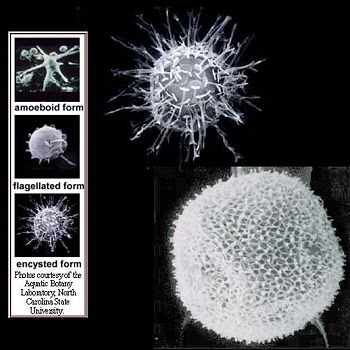Pfiesteria shumwayae
Toxicity
The Pfiesteria species contains P. shumwayae and P. piscicida, both of which have benign and toxic strains. The classification of toxicity in strains of Pfiesteria has to do with whether or not their exotoxins are inducible. In benign strains (NON-IND), toxins are not inducible; dinoflagellates are either not capable of toxic activity or the toxins they produce are negligible. Toxic strains that are actively toxic (TOX-A) or temporarily toxic (TOX-B) depend on whether there is live fish present.[1] In the presence of live fish, P. shumwayae exhibits immediate chemotaxis to fish and gradually becomes toxic. According to research done by Glasgow et al. (2001), it was demonstrated that shortly after fish death, TOX-A strains of Pfiesteria ceased production of toxins and transformed into an amoeboid form that fed on dead fish remains. In the presence of other micro-algal prey, P. shumwayae reverted to the less toxic TOX-B form. Optimal temperature for toxicity is greater than or equal to 25°C.
Experiments were done that indicate toxic strains of P. shumwayae use exotoxins to weaken fish. They can also have effects on mammals as well. Toxins secreted by dinospores are similar to an ATP transmitter that targets the P2X7 receptor [1], causing a severe inflammatory response. Cultured fish exposed to Pfiesteria toxins showed signs of depression, loss of equilibrium, hyper-excitability and decreased respiration. The physical, epidermal damage done to fish by Pfiesteria is speculated to increase the efficiency of toxins into fish tissues. Some strains of Pfiesteria that are less toxic do not kill fish unless it has direct contact with its prey.[1]
- ↑ 1.0 1.1 1.2 Glasgow, H.B.; J.A.M. Burkholder & M.A. Mallin et al. (2001), "… toxic Pfiesteria complex species and a conservative analysis of their role in estuarine fish kills", Environmental Health Perspectives: 715–730. Retrieved on 2009-04-24
